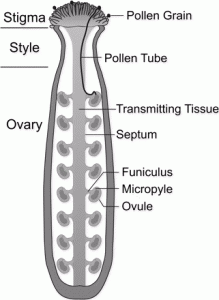Table of Contents
Introduction
The process of transfer of pollen grains from the anther of a male flower to the stigma of the female flower is known as Pollination. Pollination can be of two types which are cross-pollination and self-pollination. Most of the plants are bisexual or hermaphrodite which promotes self-pollination. Is this self-pollination desirable? What are the factors promoting cross-pollination?
What is pollen-pistil interaction?
The sequence of events, which is carried out from the time of pollen deposition over the stigma and till the entry of the pollen tube inside the ovule is called pollen pistil interaction. The process of pollination during which the transferring of pollen grains takes place from the anther to the pistil is the first step of the pollen-pistil interaction.

Outbreeding Devices
Self-pollination is common and more likely to happen in the case of hermaphrodite flowers but a successive series of self-pollination affects negatively and causes inbreeding depression. This also results in homozygous genes. Thus plants are adapted to promote cross-pollination. This is known as outbreeding. Factors which encourage cross-pollination are as follows:
- Unisexual flower: If a flower is unisexual i.e., containing only one sex either female or male, cross-pollination is the only choice.
- Non-Synchronization: Timing is important for successful self-pollination. Pollen release and receptivity of stigma should happen for successful self-pollination. Sometimes, pollen matures and releases before the stigma is open which leads to loss of pollen vitality or vice-versa. This prevents self-pollination; even though the flower is hermaphrodite.
- Self-incompatibility: Incompatibility within a flower (or plant) includes self-sterility; structural barriers. Self-sterility means even though pollination takes place it can’t proceed to fertilization due to further pollen growth failure. Structural barriers include height difference between gynoecium and androecium and some structures which hinder the stigma from receiving pollen. These are the more or less genetic mechanism.
Pollen–Pistil Interaction
All pollinations do not lead to successful fertilization because for successful fertilization, the pistil of a flower has to recognize the pollen of the same species. Therefore, the interaction between pollen grains and the stigma needs to be understood properly. Once the compatible pollen is recognised and accepted by the pistil, events for fertilization proceed. The pollen which is incompatible is rejected by the pistil so that the process of fertilization does not proceed.
Upon reaching the pistil, the pollen grain releases chemicals which are recognised by the pistil. This pollen-pistil interaction results in the acceptance of the compatible pollen.
Events of pollen-pistil interaction proceed as follows:
- The landing of true pollen on the compatible pistil.
- Germination of pollen and formation of pollen tube where pollen grains release their contents.
- Pollen tube growth through the style of the pistil towards the ovary.
- The entry of male gametes into the ovule and then to synergid.
Stay tuned with BYJU’S to learn more about Pollination, types of pollination, Pollen-Pistil Interaction, Outbreeding Devices and other related topics at BYJU’S Biology

knowledge was very fruitfull